
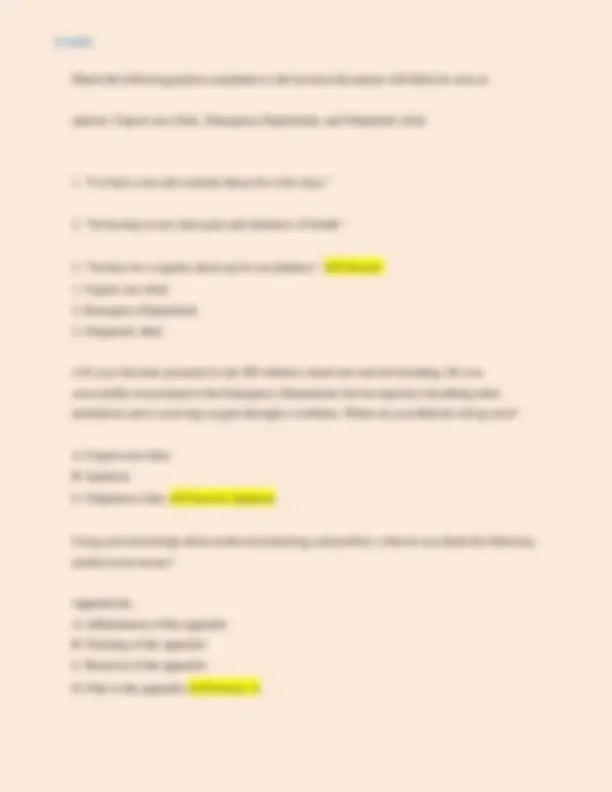
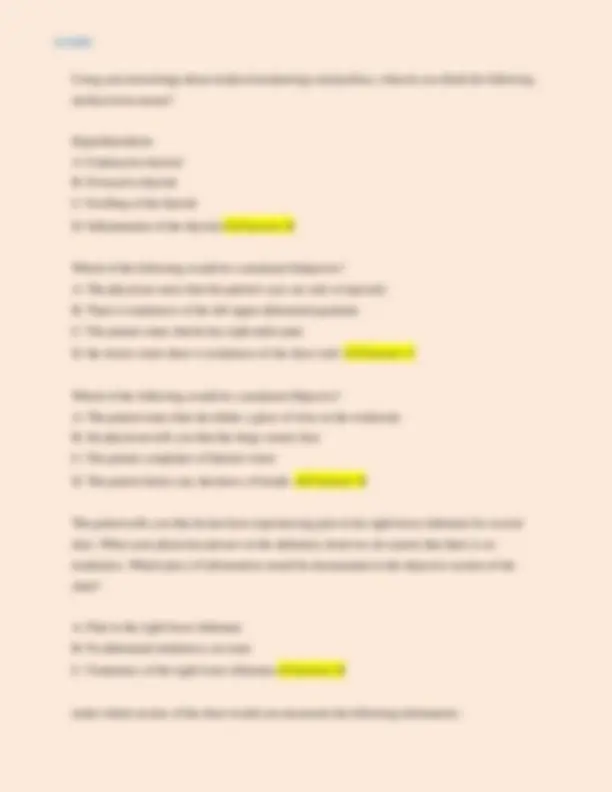
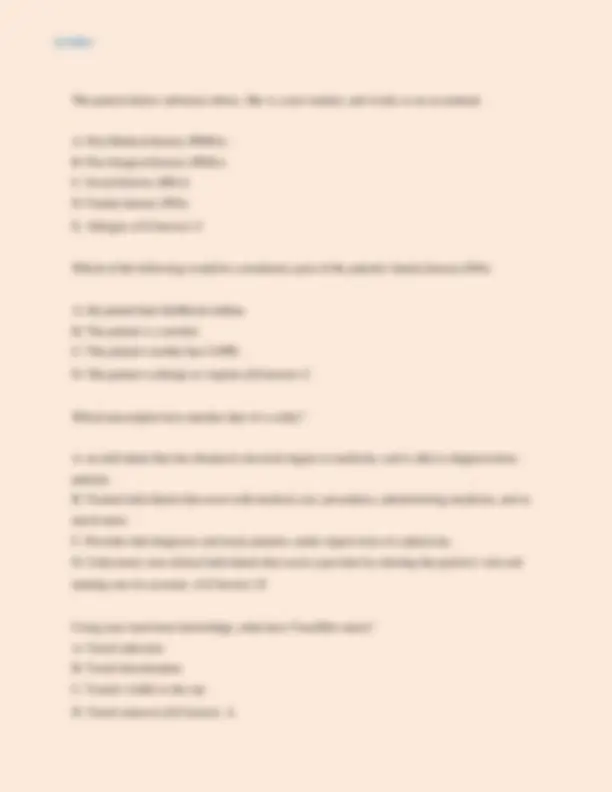
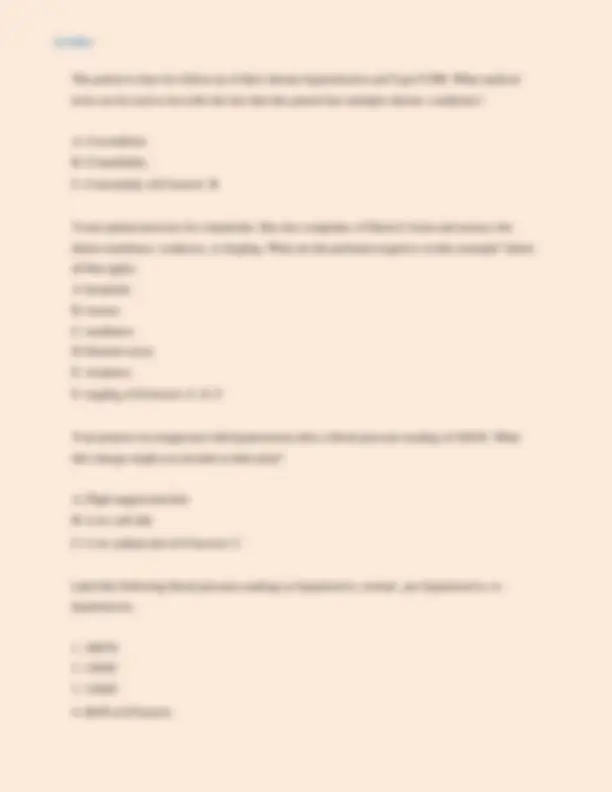
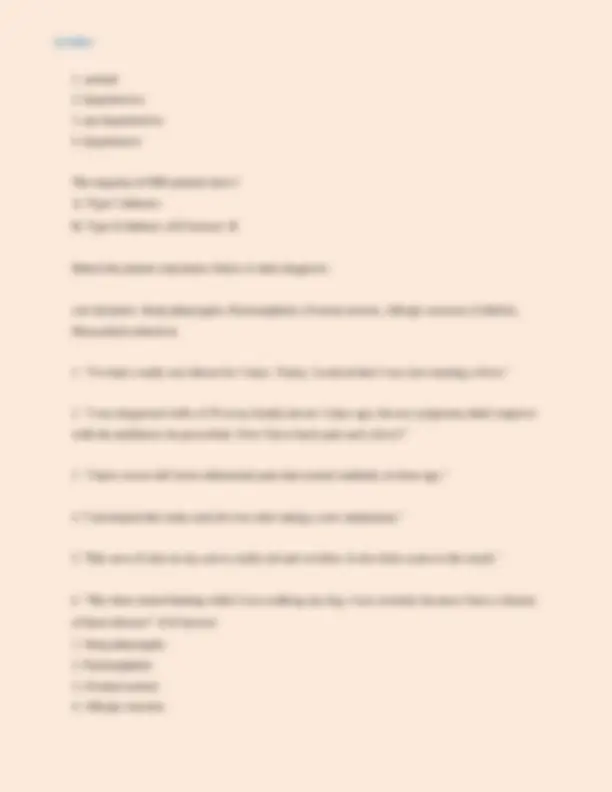
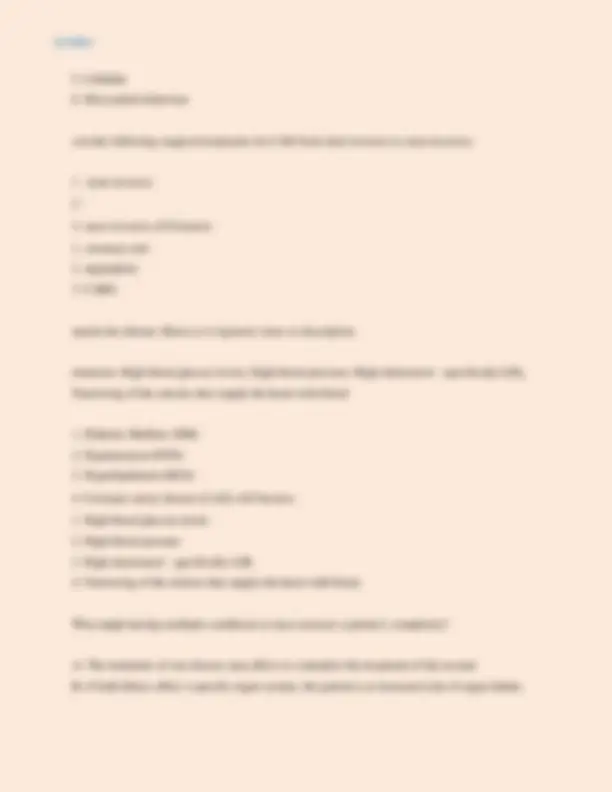
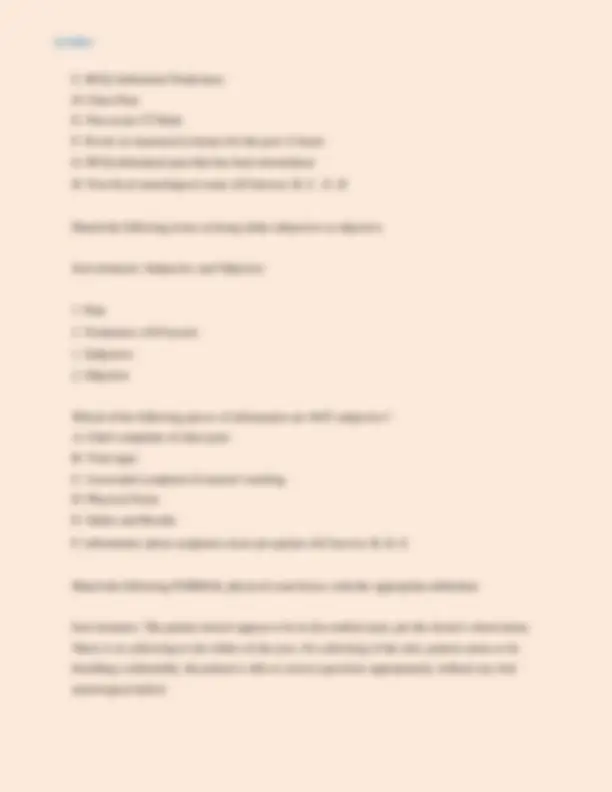
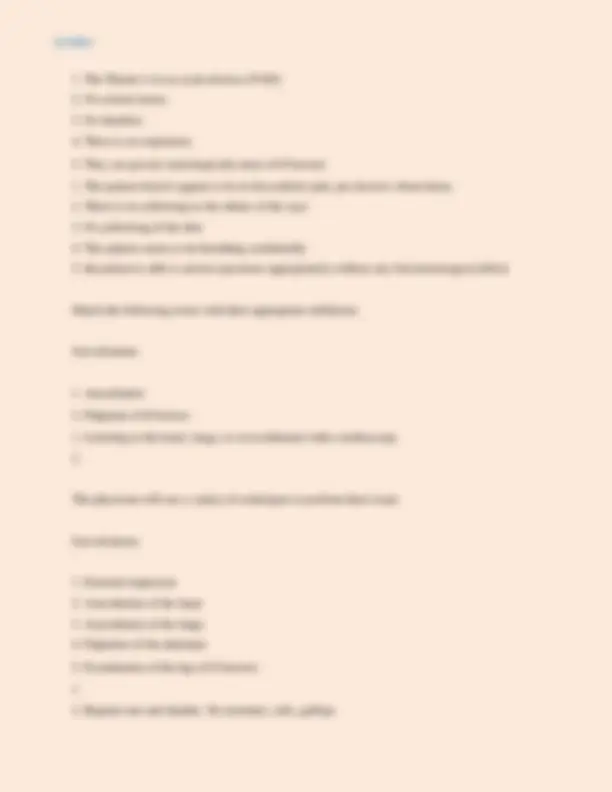
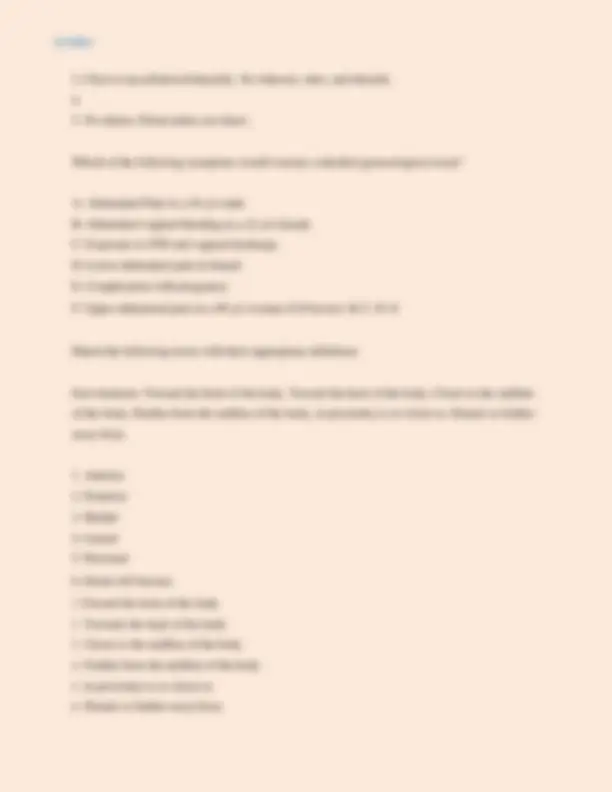
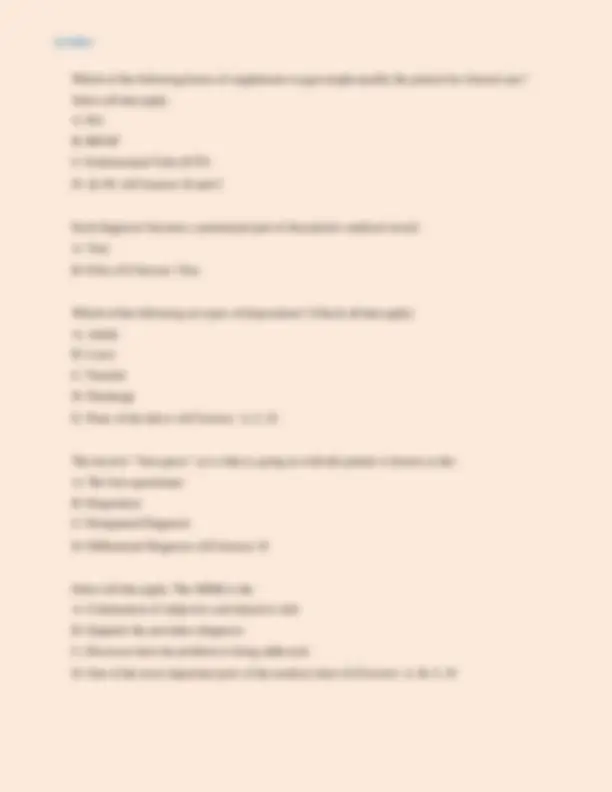
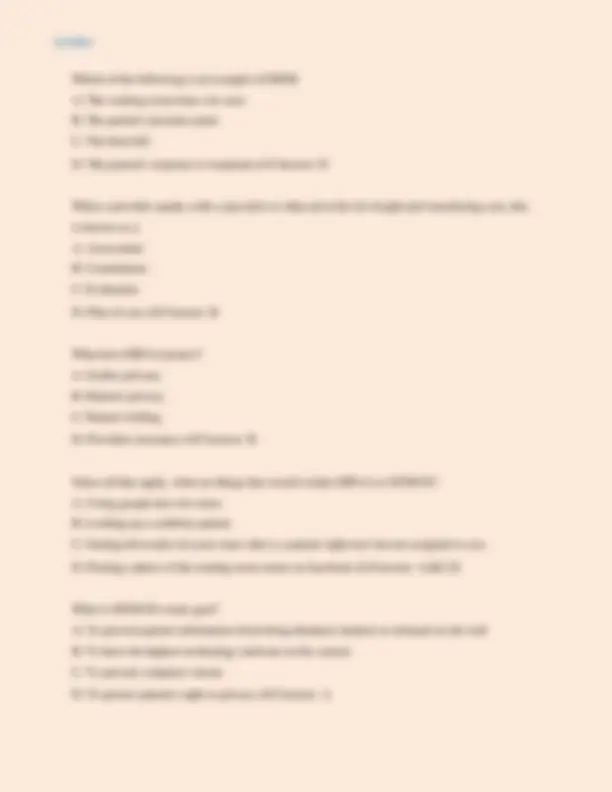
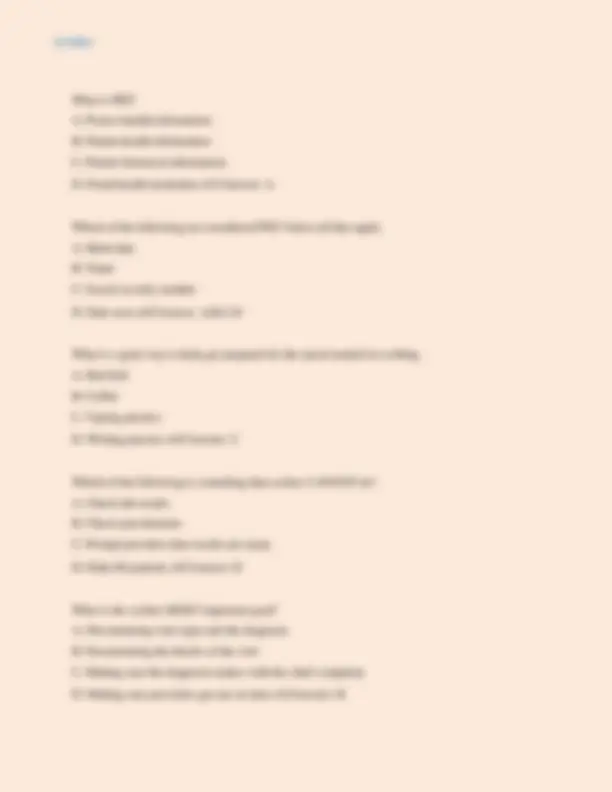
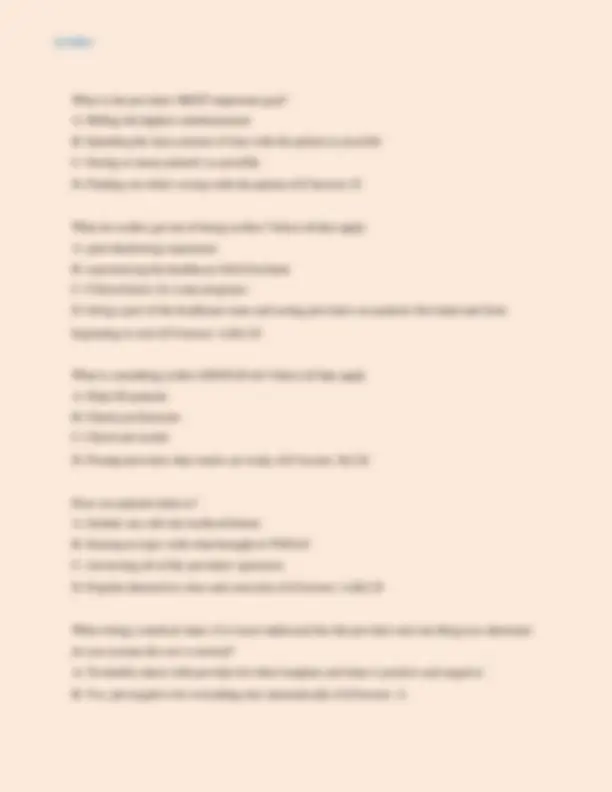
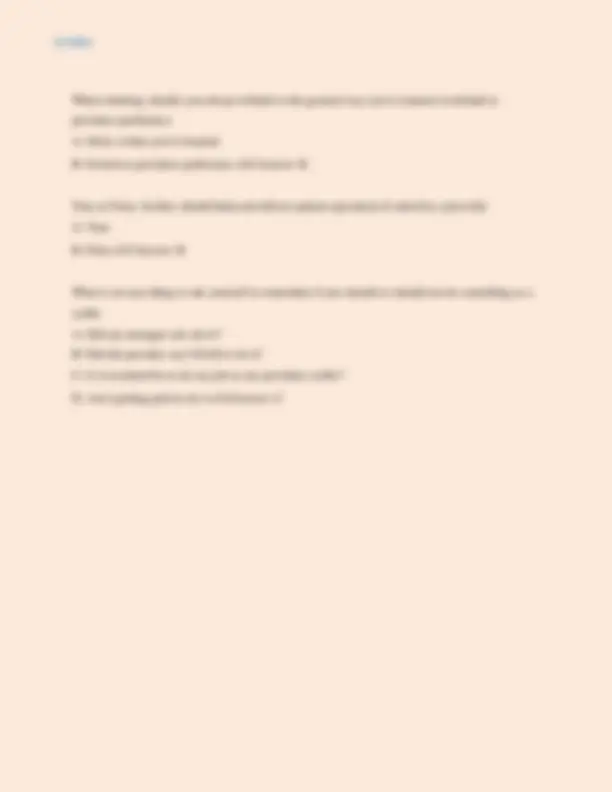


Study with the several resources on Docsity

Earn points by helping other students or get them with a premium plan


Prepare for your exams
Study with the several resources on Docsity

Earn points to download
Earn points by helping other students or get them with a premium plan
Community
Ask the community for help and clear up your study doubts
Discover the best universities in your country according to Docsity users
Free resources
Download our free guides on studying techniques, anxiety management strategies, and thesis advice from Docsity tutors
vital signs are: A: signs that you're vitally alive B: A series of measures that give an overview of a patient's overall health C: The bare minimum amount of liveliness in a person D: A neon sign that says vital ✔✔Answer: B A series of measures that give an overview of a patient's overall health Heart rate is defined as: A: The rate that your heart is pumping blood B: The rate that you fall in love C: The rate that your blood goes all around your body and back in ✔✔Answer: A Blood pressure is defined as: A: the amount of stress that your blood is under
Typology: Exams
1 / 22

This page cannot be seen from the preview
Don't miss anything!















vital signs are: A: signs that you're vitally alive B: A series of measures that give an overview of a patient's overall health C: The bare minimum amount of liveliness in a person D: A neon sign that says vital ✔✔Answer: B A series of measures that give an overview of a patient's overall health Heart rate is defined as: A: The rate that your heart is pumping blood B: The rate that you fall in love C: The rate that your blood goes all around your body and back in ✔✔Answer: A Blood pressure is defined as: A: the amount of stress that your blood is under B: the pressure at which blood is being pumped throughout your body C: The pressure at which that blood cells are made ✔✔Answer: B Which of the following is NOT a vital sign: A: Heart rate B: Blood pressure C: Respiratory rate D: Oxygen saturation E: Body weight ✔✔Answer: E Someone who is breathing really fast and short of breath is MOST likely: A: Tachycardic B: Tachypneic
C: Bradycardic D: Bradypneic ✔✔Answer: B Someone who has smoked for many years and is short of breath is MOST likely: A: Hypertensive B: Hypoxic C: Hyperoxic D: Hypotensive ✔✔Answer: B A person who is very stressed while watching a scary movie is MOST likely: A: Tachycardic B: Tachypneic C: Bradycardic D: Bradypneic ✔✔Answer: A A sick child who has a fever for two hours likely has which temperature? A: 98. B: 102. C: 99. D: 97.9 ✔✔Answer: B Oxygen saturation is defined as: A: The saturation of oxygen in your lungs B: The saturation of oxygen in your blood C: How saturated blood is on your oxygen D: The rate of breaths per minute as measured in your fingertip ✔✔Answer: B True or False: Vital signs are usually measured in rate how many times a second is it happening ✔✔Answer: False
Using your knowledge about medical terminology and prefixes, what do you think the following medical term means? Hyperthyroidism A: Underactive thyroid B: Overactive thyroid C: Swelling of the thyroid D: Inflammation of the thyroid ✔✔Answer: B Which of the following would be considered Subjective? A: The physician states that the patient's eyes are red( or injected). B: There is tenderness of the left upper abdominal quadrant. C: The patient states that he has right ankle pain. D: the doctor states there is tenderness of the chest wall. ✔✔Answer: C Which of the following would be considered Objective? A: The patient states that she drinks a glass of wine on the weekends. B: the physician tells you that the lungs sound clear C: The patient complains of blurred vision D: The patient denies any shortness of breath. ✔✔Answer: B The patient tells you that he has been experiencing pain in his right lower abdomen for several days. When your physician presses on the abdomen, however, he reports that there is no tenderness. Which piece of information would be documented in the objective section of the chart? A: Pain in the right lower abdomen B: No abdominal tenderness on exam C: Tenderness of the right lower abdomen ✔✔answer: B under which section of the chart would you document the following information :
The patient denies substance abuse. She is a non-smoker, and works as an accountant A: Past Medical history (PMHx) B: Past Surgical history (PSHx) C: Social history (SHx)) D: Family history (FHx) E: Allergies ✔✔Answer: C Which of the following would be considered a part of the patient's family history (FHx) A: the patient had childhood asthma. B: The patient is a smoker. C: The patient's mother has COPD. D: The patient is allergic to Aspirin ✔✔answer: C Which description best matches that of a scribe? A: an individual that has obtained a doctoral degree in medicine, and is able to diagnose/treat patients. B: Trained individuals that assist with medical care, procedures, administering medicine, and so much more. C: Provider that diagnoses and treats patients, under supervision of a physician. D: Unlicensed, non-clinical individuals that assist a provider by charting the patient's visit and making sure its accurate. ✔✔Answer: D Using your med terms knowledge, what does Tonsillitis mean? A: Tonsil infection B: Tonsil discoloration C: Tonsils visible to the eye D: Tonsil removal ✔✔Answer: A
"Heart disease" is also known as: A: Coronary Artery Disease B: Coronary Arterial Deficit C: Congestive Artery Disconnect D: Myocardial infarction ✔✔Answer: A The prefix Hepa corresponds to which organ? A: Spleen B: Appendix C: Liver D: Diverticulum ✔✔Answer: C A UTI is unresolved and goes to the kidneys is known as: A: Renal Calculi B: Urinary Tract Infection C: Pyelonephritis D: Chronic Kidney Disease ✔✔Answer: C GPA is a measure we use to document what A: A patient's grade point average B: A patient's surgery history C: A patient's gastric surgery history D: A patient's pregnancy history ✔✔Answer: D While your provider is discussing the patient's past medical history, the patient reports right knee pain that began 2 years ago. Her orthopedic diagnosed her with arthritis. Is this condition considered acute or chronic? A: Acute B: Chronic ✔✔Answer: B
The patient is here for follow up of their chronic hypertension and Type ll DM. What medical term can be used to describe the fact that this patient has multiple chronic conditions? A: Cocondition B: Comorbidity C: Comortality ✔✔Answer: B Yoour patient presents for a headache. She also complains of blurred vision and nausea, but denies numbness, weakness, or tingling. What are the pertinent negatives in this example? Select all that apply. A: headache B: nausea C: numbness D: blurred vision E: weakness F: tingling ✔✔Answer: C, E, F Your patient was diagnosed with hypertension after a blood pressure reading of 168/85. What diet change might you include in their plan? A: High magnesium diet B: Low carb diet C: Low sodium diet ✔✔Answer: C Label the following blood pressure readings as hypotensive, normal , pre-hypertensive, or hypertensive.
C: Compounding symptoms and medication interactions may lead to poor compliance with treatment plan. D: All of the above. ✔✔Answer: D Abdominal tenderness belongs in which part of the chart A: HPI B: ROS C: PE D: Assessment E: Plan ✔✔Answer: C IT'S TOTALLY OK TO WRITE IN ALL CAPS IN THE HPI A: True B: False ✔✔Answer: B The HPI will have everything from the ROS ✔✔Answer: B The clues that make up the HPI are what we know as A: Deductions B: Evidence C: Elements D: Hints ✔✔Answer: C SOAP stands for: A: A clean chart B: Suspect Object Apprehend and Parephrase C: Subjective Objective Assessment and Plan D: Subjective Object Answers and Plan ✔✔Answer: C
C: RUQ Abdominal Tenderness D: Chest Pain E: Non-acute CT Head F: Fever( no measured at home) for the past 12 hours G: RUQ abdominal pain that has been intermittent H: Non-focal neurological exam ✔✔Answer: B, C , E, H Match the following terms as being either subjective or objective Sort elements: Subjective and Objective
The physician will use a variety of techniques to perform their exam. Sort elements:
The doctor dictates "5/5 Motor strength to the bilateral upper and lower extremities. Sensation intact. No pronator drift "to you across the room. Which type of exam is being preformed? A: External Exam B: Basic Exam C: Detailed Exam ✔✔Answer: C Which of the following would be included in a CBC? Select all that apply. A: WBC B: Electrolytes C: H&H D: Glucose E: LFTs ✔✔Answer: A, C Which of the following would be included in a BMP? (Select all that apply.) A: WBC B: Electrolytes C: H&H D: Glucose E: Creatinine (Kidney function) ✔✔Answer: B, D, E If a patient overdoses on Acetaminophen(Tylenol), it can injure the liver. What test would you ordered to assess the patient's liver function? A: CBC B: CMP C: BMP D: X-ray of the abdomen ✔✔Answer: B
An 11 year old patient fell off a trampoline earlier today, and presents with right wrist pain. Which test is your provider likely to order, to evaluate the patient's pain? A: CT A/P with PO contrast B: X- ray of the right wrist C: CBC of the right wrist D: Urinalysis ✔✔Answer: B A gastrointestinal perforation( also as ruptured bowel) is a highly emergent condition that occurs when there is a hole in the wall of part of the GI tract. What test would be best to evaluate this condition? A: Chest x-ray B: CT A/P C: CT angiogram of brain D: Ultrasound of the right upper quadrant ✔✔Answer: B Your patient presented for severe testicular pain, without known trauma. Your provider is concerned about a testicular torsion. What test will he/she most likely order to look for a torsion? A: CT of the pelvis B: X-ray of the hip C: Ultrasound of the testicles ✔✔Answer: C EKG documentation can include which of the following elements: A: Rate/Rhythm B: Axis C: Intervals D: ST segments E: Comparison to prior EKG F: Clinical context H: All of the above ✔✔Answer: H
Which of the following is an example of MDM A: The waiting room time o be seen B: The patient's insurance plan C: The final bill D: The patient's response to treatment ✔✔Answer: D When a provider speaks with a specialist or other provider for insight and transferring care, this is known as a: A: Assessment B: Consultation C: Evaluation D: Plan of care ✔✔Answer: B What does HIPAA protect? A: Scribes privacy B: Patient's privacy C: Patient's billing D: Providers insurance ✔✔Answer: B Select all that apply, what are things that would violate HIPAA or HITECH? A: Using google docs for notes B: Looking up a celebrity patient C: Getting lab results for your sister who is a patient right now but not assigned to you D: Posting a photo of the waiting room roster on facebook ✔✔Answer: A,B,C,D What is HITECH's main goal? A: To prevent patient information from being obtained, hacked, or released on the web B: To have the highest technology malware on the system C: To prevent computer viruses D: To protect patient's right to privacy ✔✔Answer: A
What is PHI? A: Protect health information B: Patient health information C: Patient historical information D: Portal health institution ✔✔Answer: A Which of the following are considered PHI? Select all that apply A: Birth date B: Name C: Social security number D: Date seen ✔✔Answer: A,B,C,D What is a great way to help get prepared for the speed needed in scribing A: Red bull B: Coffee C: Typing practice D: Writing practice ✔✔Answer: C Which of the following is something that scribes CANNOT do? A: Check lab results B: Check past histories C: Prompt providers that results are ready D: Help lift patients ✔✔Answer: D What is the scribes MOST important goal? A: Documenting vital signs and the diagnosis B: Documenting the details of the visit C: Making sure the diagnosis makes with the chief complaint D: Making sure providers get out on time ✔✔Answer: B